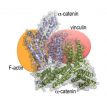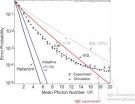"Our research identifies a molecular pathway by which morphine can increase pain, and suggests potential new ways to make morphine effective for more patients," says senior author Dr. Yves De Koninck, Professor at Université Laval in Quebec City. The team included researchers from The Hospital for Sick Children (SickKids) in Toronto, the Institut universitaire en santé mentale de Québec, the US and Italy.
New pathway in pain management
The research not only identifies a target pathway to suppress morphine-induced pain but teases apart the pain hypersensitivity caused by morphine from tolerance to morphine, two phenomena previously considered to be caused by the same mechanisms.
"When morphine doesn't reduce pain adequately the tendency is to increase the dosage. If a higher dosage produces pain relief, this is the classic picture of morphine tolerance, which is very well known. But sometimes increasing the morphine can, paradoxically, makes the pain worse," explains co-author Dr. Michael Salter. Dr. Salter is Senior Scientist and Head of Neurosciences & Mental Health at SickKids, Professor of Physiology at University of Toronto, and Canada Research Chair in Neuroplasticity and Pain.
"Pain experts have thought tolerance and hypersensitivity (or hyperalgesia) are simply different reflections of the same response," says Dr. De Koninck, "but we discovered that cellular and signalling processes for morphine tolerance are very different from those of morphine-induced pain."
Dr. Salter adds, "We identified specialized cells – known as microglia – in the spinal cord as the culprit behind morphine-induced pain hypersensitivity. When morphine acts on certain receptors in microglia, it triggers the cascade of events that ultimately increase, rather than decrease, activity of the pain-transmitting nerve cells."
The researchers also identified the molecule responsible for this side effect of morphine. "It's a protein called KCC2, which regulates the transport of chloride ions and the proper control of sensory signals to the brain," explains Dr. De Koninck. "Morphine inhibits the activity of this protein, causing abnormal pain perception. By restoring normal KCC2 activity we could potentially prevent pain hypersensitivity." Dr. De Koninck and researchers at Université Laval are testing new molecules capable of preserving KCC2 functions and thus preventing hyperalgesia.
The KCC2 pathway appears to apply to short-term as well as to long-term morphine administration, says Dr. De Koninck. "Thus, we have the foundation for new strategies to improve the treatment of post-operative as well as chronic pain."
Dr. Salter adds, "Our discovery could have a major impact on individuals with various types of intractable pain, such as that associated with cancer or nerve damage, who have stopped morphine or other opiate medications because of pain hypersensitivity."
Cost of pain
Pain has been labelled the silent health crisis, afflicting tens of millions of people worldwide. Pain has a profound negative effect on the quality of human life. Pain affects nearly all aspects of human existence, with untreated or under-treated pain being the most common cause of disability. The Canadian Pain Society estimates that chronic pain affects at least one in five Canadians and costs Canada $55-60 billion per year, including health care expenses and lost productivity.
"People with incapacitating pain may be left with no alternatives when our most powerful medications intensify their suffering," says Dr. De Koninck, who is also Director of Cellular and Molecular Neuroscience at Institut universitaire en santé mentale de Québec.
Dr. Salter adds, "Pain interferes with many aspects of an individual's life. Too often, patients with chronic pain feel abandoned and stigmatized. Among the many burdens on individuals and their families, chronic pain is linked to increased risk of suicide. The burden of chronic pain affects children and teens as well as adults." These risks affect individuals with many types of pain, ranging from migraine and carpel-tunnel syndrome to cancer, AIDS, diabetes, traumatic injuries, Parkinson's disease and dozens of other conditions.
INFORMATION:
Canadian funding for this international research included Canadian Institutes for Health Research, Krembil Foundation, Ontario Research Fund Research Excellence Program, Fonds de la recherche en santé du Québec, Canada Research Chair funding, The Anne and Max Tanenbaum Chair Program, SickKids Foundation, and Université Laval.
About Université Laval
Located in Quebec City, the province's historic capital and a World Heritage City, Université Laval is the first French-language university in North America. It is one of Canada's leading research universities, ranking 7th among the country's 94 university-level institutions in terms of research funding with $300 million devoted to research last year. Université Laval's 1,500 professors-researchers share their knowledge with 45,000 students, 10,000 of whom are enrolled in graduate-level programs. For more information, please visit www.ulaval.ca.
About the Institut universitaire en santé mentale de Québec
The Research Centre of the Institut universitaire en santé mentale de Québec (IUSMQ) is one of Canada's leading and fastest growing institutions dedicated to understanding the causes of neurological and psychiatric diseases in children, adults and the elderly and to improving their treatment. Founded more than 25 years ago in Quebec City and affiliated with Université Laval, the Research Centre brings together some 400 researchers, trainees and research professionals in uniquely trans-disciplinary efforts to solve the mysteries of the healthy and diseased brain and to further the development of novel therapeutics.
About The Hospital for Sick Children
The Hospital for Sick Children (SickKids) is recognized as one of the world's foremost paediatric health-care institutions and is Canada's leading centre dedicated to advancing children's health through the integration of patient care, research and education. Founded in 1875 and affiliated with the University of Toronto, SickKids is one of Canada's most research-intensive hospitals and has generated discoveries that have helped children globally. Its mission is to provide the best in complex and specialized family-centred care; pioneer scientific and clinical advancements; share expertise; foster an academic environment that nurtures health-care professionals; and champion an accessible, comprehensive and sustainable child health system. SickKids is proud of its vision for Healthier Children. A Better World. For more information, please visit www.sickkids.ca.
About SickKids Centre for Research and Learning
The SickKids Centre for Research and Learning will bring together researchers from different scientific disciplines and a variety of clinical perspectives, to accelerate discoveries, new knowledge and their application to child health – a different concept from traditional research building designs. The facility will physically connect SickKids science, discovery and learning activities to its clinical operations. Designed by award-winning architects Diamond + Schmitt Inc. and HDR Inc. with a goal to achieve LEED® Gold Certification for sustainable design, the Centre will create an architectural landmark as the eastern gateway to Toronto's Discovery District. The SickKids Centre for Research and Learning is funded by a grant from the Canada Foundation for Innovation, the Government of Ontario, philanthropist Peter Gilgan and community support for the ongoing fundraising campaign. For more information, please visit www.sickkidsfoundation.com/bepartofit.
Information:
Yves De Koninck
Faculty of Medicine
Université Laval
Quebec City, Canada
Yves.DeKoninck@crulrg.ulaval.ca
Polly Thompson
The Hospital for Sick Children
Toronto, Canada
(416) 813-7654, ext. 2059
polly.thompson@sickkids.ca
END





